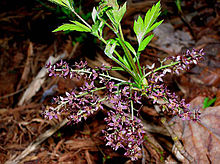Please be sure to read the disclaimer at the end of this article.
When I was a youngster , folks called Golden Seal “Yellow Root”. Then when I was traveling the AT , I ran into it – only it was a different plant! The lady I met used it as a dye plant for her wool. This is a good example of the practical reason for learning the botanical names of plants- the local names can be very similar.
Yellow Root- Xanthorhiza simplicissima

This little plant is found most often on stream banks and in very moist woods. It resembles poison ivy so be very sure of your ID ! Leaves are usually only on the upper part of the tall woody stem. There are mostly 5 leaves with the smaller ones being divided. The roots are a rich yellow color. They usually run very deep. The flowers are sometimes hard to find- they droop and are a rich burgundy color.

They seem to wait for a little bit warmer weather- late April and May.
Actions:
Anti inflammatory, astringent, hemostatic, antimicrobial, anticonvulsant, immune-stimulant, uterotonic.
Active Component :
Berberine- Potentially toxic if overused,
Folklore uses- oldtimers would use it for arthritic pain ,to stop diarrhea and to lower blood sugar and high blood pressure. The root can stimulate secretion of bile and bilirubin- so was used for liver problems.
Hopefully this will create some interest in this shy little plant !
Disclaimer:
This is not intended as medical advice- only to share folk lore. Please do not use any herbal preparation without the advice of a licensed practitioner. Be absolutely certain of your plant ID. Many of the herbs growing wild have toxic or deadly look-a-likes.
